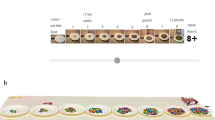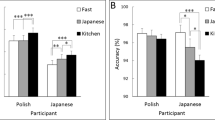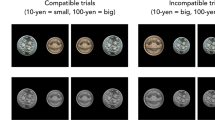Abstract
Objective:
The Delboeuf Illusion affects perceptions of the relative sizes of concentric shapes. This study was designed to extend research on the application of the Delboeuf illusion to food on a plate by testing whether a plate’s rim width and coloring influence perceptual bias to affect perceived food portion size.
Design and methods:
Within-subjects experimental design. Experiment 1 tested the effect of rim width on perceived food portion size. Experiment 2 tested the effect of rim coloring on perceived food portion size. In both experiments, participants observed a series of photographic images of paired, side-by-side plates varying in designs and amounts of food. From each pair, participants were asked to select the plate that contained more food. Multilevel logistic regression examined the effects of rim width and coloring on perceived food portion size.
Results:
Experiment 1: participants overestimated the diameter of food portions by 5% and the visual area of food portions by 10% on plates with wider rims compared with plates with very thin rims (P<0.0001). The effect of rim width was greater with larger food portion sizes. Experiment 2: participants overestimated the diameter of food portions by 1.5% and the visual area of food portions by 3% on plates with rim coloring compared with plates with no coloring (P=0.01). The effect of rim coloring was greater with smaller food portion sizes.
Conclusion:
The Delboeuf illusion applies to food on a plate. Participants overestimated food portion size on plates with wider and colored rims. These findings may help design plates to influence perceptions of food portion sizes.
This is a preview of subscription content, access via your institution
Access options
Subscribe to this journal
Receive 12 print issues and online access
$259.00 per year
only $21.58 per issue
Buy this article
- Purchase on Springer Link
- Instant access to full article PDF
Prices may be subject to local taxes which are calculated during checkout




Similar content being viewed by others
References
Wansink B . Environmental factors that increase the food intake and consumption volume of unknowing consumers. Annu Rev Nutr 2004; 24: 455–479.
Fisher JO, Kral TV . Super-size me: portion size effects on young children's eating. Physiol Behav 2008; 94: 39–47.
Rolls BJ . The supersizing of America: portion size and the obesity epidemic. Nutr Today 2003; 38: 42–53.
Rolls BJ, Morris EL, Roe LS . Portion size of food affects energy intake in normal-weight and overweight men and women. Am J Clin Nutr 2002; 76: 1207–1213.
Ello-Martin JA, Ledikwe JH, Rolls BJ . The influence of food portion size and energy density on energy intake: implications for weight management. Am J Clin Nutr 2005; 82: 236S–241S.
Diliberti N, Bordi PL, Conklin MT, Roe LS, Rolls BJ . Increased portion size leads to increased energy intake in a restaurant meal. Obes Res 2004; 12: 562–568.
Wansink B, Cheney MM . Super bowls: serving bowl size and food consumption. JAMA 2005; 293: 1727–1728.
Wansink B, Painter JE, North J . Bottomless bowls: why visual cues of portion size may influence intake. Obes Res 2005; 13: 93–100.
Folkes V, Matta S . The effect of package shape on consumers’ judgments of product volume: attention as a mental contaminant. J Cons Res 2004; 31: 390–401.
Wansink B . Can package size accelerate usage volume? J Marketing 1996; 60: 1–13.
Wansink B, Kim J . Bad popcorn in big buckets: portion size can influence intake as much as taste. J Nutr Educ Behav 2005; 37: 242–245.
McCrory MA, Fuss PJ, McCallum JE, Yao M, Vinken AG, Hays NP et al. Dietary variety within food groups: association with energy intake and body fatness in men and women. Am J Clin Nutr 1999; 69: 440–447.
Rolls BJ, Rowe EA, Rolls ET, Kingston B, Megson A, Gunary R . Variety in a meal enhances food intake in man. Physiol Behav 1981; 26: 215–221.
Wansink B . Mindless Eating: Why We Eat More Than We Think. Bantam Dell: New York, NY, USA, 2006.
Young LR, Nestle M . The contribution of expanding portion sizes to the US obesity epidemic. Am J Public Health 2002; 92: 246–249.
Pratt IS, Croager EJ, Rosenberg M . The mathematical relationship between dishware size and portion size. Appetite 2012; 58: 299–302.
Van Ittersum K, Wansink B . Plate size and color suggestibility: the Delboeuf Illusion’s bias on serving and eating behavior. J Consumer Res 2012; 39: 215–228.
Rolls BJ, Roe LS, Halverson KH, Meengs JS . Using a smaller plate did not reduce energy intake at meals. Appetite 2007; 49: 652–660.
Delboeuf FJ . “Note Sur Certaines Illusions d’Optique: Essai d’une Théorie Psychophysique de la Manière don’t l’Oeil Apprécie les Distances et les Angles [Note on Certain Optical illusions: Essay on a Phychophysical Theory Concerning the Way in Which the Eye Evaluates Distances and Angles]”. Bulletins de l’Académie Royale des Sciences, Lettres et Beaux-arts de Belgique 1865; 19: 195–216.
Jaeger T, Long S . Effects of contour proximity and lightness on Delboeuf illusions created by circumscribed letters. Percept Mot Skills 2007; 105: 253–260.
Surkys T, Bertulis A, Bulatov A . Delboeuf illusion study. Medicina (Kaunas) 2006; 42: 673–681.
Weintraub DJ, Cooper LA . Coming of age with the Delboeuf illusion: brightness contrast, cognition, and perceptual development. Develop Psychol 1972; 6: 187–197.
Weintraub DJ, Wilson BA, Greene RD, Palmquist MJ . Delboeuf illusion: displacement versus diameter, arc deletions, and brightness contrast. J Exp Psychol 1969; 80: 505–511.
Morinaga S . Conditions of the size-assimilation and size-contrast. In Hirose K (ed.) Masuda Hakushi Shaon Saikin Shinrigaku Ronbunsyuu. Tokoy: Iwanami,, 1935. pp 28–48.
Girgus JS, Coren S . Assimilation and contrast illusions: differences in plasticity. Percep Psychophys 1982; 32: 555–561.
Pollack RH . The effects of fixation upon the apparent magnitude of bounded horizontal extent. Am J Psychol 1964; 77: 177–192.
Oyama T . The effect of hue and brightness on the size-illusion of concentric circles. Am J Psychol 1962; 75: 45–55.
Jaeger T, Lorden R . Delboeuf illusions: contour or size detector interactions? Percept Mot Skills 1980; 50: 376–378.
Rand DG . The promise of mechanical turk: how online labor markets can help theorists run behavioral experiments. J Theor Biol 2011; 299: 172–179.
Paolacci G, Chandler J, Ipeirotis PG . Running experiments on Amazon Mechanical Turk. Judg Decis Making 2010; 5: 411–419.
Stevens SS . Psychophysics: Introduction to its Perceptual, Neural, and Social Prospects. Transaction Publishers: New Brunswick, NJ, USA, 1975.
Cronbach LJ, Snow RE . Aptitudes and Instructional Methods: a Handbook for Research on Interactions. Ardent Media: New York, NY, USA, 1981.
Finney JW, Mitchell RE, Cronkite RC, Moos RH . Methodological issues in estimating main and interactive effects: examples from coping/social support and stress field. J Health Soc Behav 1984; 25: 85–98.
Rogosa D . Comparing nonparallel regression lines. Psychol Bull 1980; 88: 307.
Overall JE, Lee DM, Hornick CW . Comparison of two strategies for analysis of variance in nonorthogonal designs. Psychol Bull 1981; 90: 367.
Kraemer HC, Blasey CM . Centring in regression analyses: a strategy to prevent errors in statistical inference. Int J Methods Psychiatr Res 2004; 13: 141–151.
Hill JO, Wyatt HR, Reed GW, Peters JC . Obesity and the environment: where do we go from here? Science 2003; 299: 853–855.
Hall KD, Sacks G, Chandramohan D, Chow CC, Wang YC, Gortmaker SL et al. Quantification of the effect of energy imbalance on bodyweight. Lancet 2011; 378: 826–837.
Wansink B, van Ittersum K, Painter JE . Ice cream illusions bowls, spoons, and self-served portion sizes. Am J Prev Med 2006; 31: 240–243.
Acknowledgements
This research was supported, in part, by Award Numbers R01HL096015 and U01HL103629 from the National Heart, Lung, and Blood Institute and the Children’s Health Research Institute at the Stanford University. Dr McClain was supported by Public Health Service Training Grant 5 T32 HL 007034 from the National Heart, Lung, and Blood Institute.
DISCLAIMER
The content is solely the responsibility of the authors and does not necessarily represent the official views of the National Heart, Lung, And Blood Institute, the National Institutes of Health, or Stanford University.
Author information
Authors and Affiliations
Corresponding author
Ethics declarations
Competing interests
The authors declare no conflict of interest.
Additional information
AUTHOR CONTRIBUTIONS
Study design (AM, WV, DM, SM and TR), data collection (AM and WV), data interpretation (AM, WV, DM, MD, SM and TR), literature search (AM and TR), generation of figures (AM, WV, MD and SM), writing of the manuscript (AM, WV, DM, MD, SM and TR).
Rights and permissions
About this article
Cite this article
McClain, A., van den Bos, W., Matheson, D. et al. Visual illusions and plate design: the effects of plate rim widths and rim coloring on perceived food portion size. Int J Obes 38, 657–662 (2014). https://doi.org/10.1038/ijo.2013.169
Received:
Revised:
Accepted:
Published:
Issue Date:
DOI: https://doi.org/10.1038/ijo.2013.169



